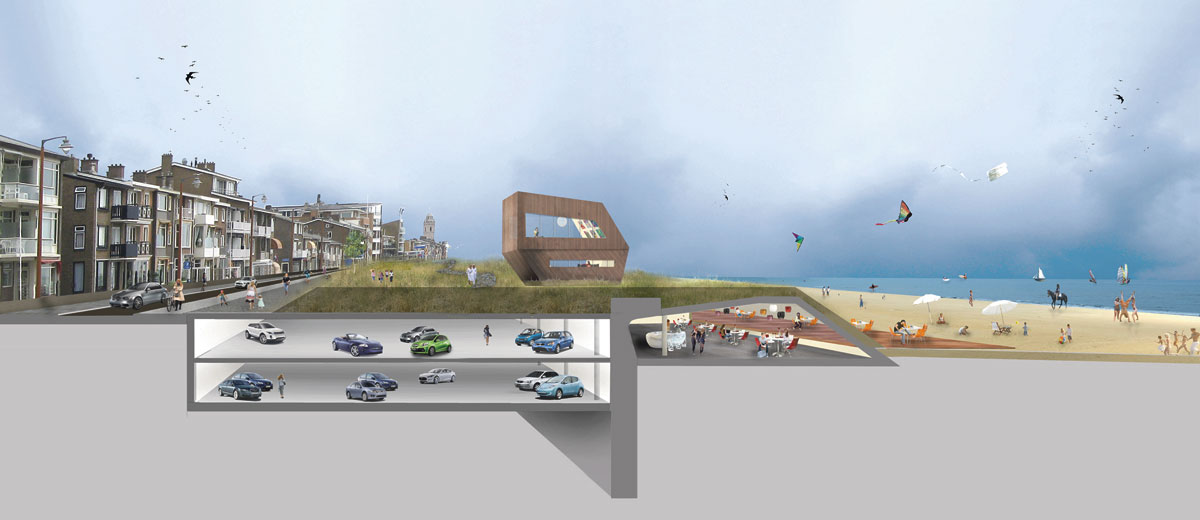A new dike needs to be built along the coast of Katwijk, offering new opportunities to combine safety with leisure, business and sightseeing.
Many residents of Katwijk, a small coastal town between Den Haag and Leiden, are now solely protected from floodwaters by a meagre row of small dunes. There is however a dike that protects the hinterland, but it runs right through the middle of Katwijk. A new dike therefore needs to be built to protect all residents from super storms.
The government’s initial plan was to allow nature to do part of the work. By dumping huge quantities of sand a little ways off the coast, the dunes would regain strength naturally as the sand washes ashore. But big dunes would ruin the nice view of the sea from Katwijk’s boulevard, so the local municipality came with another idea: a dike hidden within a smaller dune. The cost of realizing this plan, which demands less sand nourishment, is estimated to be approximately 32 million euros.
Researchers from the think tank ‘multikering’ (a word play signifying multifunctional dike) however elaborated on this idea and now believe they can do better, while at the same time saving the government and municipality more than half of initial total cost estimate.
Researchers from TU Delft, TNO, Rotterdam’s municipal engineering department, CUR building and infrastructure, and other agencies, suggest using 15 to 20 meter deep concrete diaphragm (water-blocking) walls, which are frequently used for tunnel constructions and quay walls. Seen from above their creation looks like a standard dike, but in fact it is hollow and accommodates car parks on the landside and cafes and restaurants on the seaside.
“With sand nourishment you can do a lot and it’s cheap,” says PhD student Wim Kanning (faculty of Civil Engineering & Geosciences), who is involved in the project. “Yet in places like Katwijk where hard structures are so close to the sea and the row of dunes so thin, you must continually add sand to counter erosion, which makes it very expensive.”
Kanning and his colleagues, Jarit de Gijt (CEG faculty) and Ton Siemerink (CUR), believe diaphragm walls are extremely useful in such circumstances. “Unfortunately, water boards and Rijkswaterstaat are very conservative,” says De Gijt. “They want to be able to inspect dikes by strolling over them,” Siemerink adds. “And the problem with diaphragms is that you can’t see them from the outside.”
The three researchers, who also assert that the condition of the concrete diaphragms can easily be monitored with sensors, will present their concept on 1 November, during the ‘battle of concepts’ in Katwijk.
Staatssecretaris van hoger onderwijs Halbe Zijlstra is blij met de conclusies van de inspectie. Hij hoopt het wetsvoorstel voor de verplichte harde knip (het principe ‘eerst je bachelor, dan je master’) binnenkort in de Tweede Kamer te bespreken, schrijft hij in een beleidsreactie.
Toch verdient een aantal zaken nadere aandacht bij de invoering van de harde knip, stelt de onderwijsinspectie in haar rapport “Toelating tot de universitaire masteropleiding”. Zo moet worden voorkomen dat door de harde knip bachelorprogramma’s in de knel komen doordat zij bijvoorbeeld compacter, zwaarder of minder flexibel worden.
De staatssecretaris is het daarmee eens, maar het belangrijkst is volgens hem dat studenten straks weten waar ze aan toe zijn. Ze moeten rekening kunnen houden met de harde knip en met de eisen om toegelaten te worden tot de master van hun keuze. Nu steeds meer masteropleidingen hun studenten selectief toelaten, is het van belang dat de criteria glashelder zijn en de selectieprocedure betrouwbaar is.
Verder neemt hij de aanbevelingen over dat masteropleidingen meerdere instroommomenten door het jaar heen moeten creëren om de studievertraging voor studenten te beperken. Nu biedt iets minder dan de helft van de opleidingen die mogelijkheid. De staatssecretaris schat dat dit voor ongeveer tien procent van het masteraanbod niet haalbaar zal zijn, bijvoorbeeld omdat ze het niet kunnen betalen.
Om de overgang tussen bachelor en master soepel te laten verlopen wil Zijlstra net als de inspectie dat bacheloropleidingen bij de planning van hun herkansingen rekening houden met de instroomdata van de masters.
Ook de aanbeveling dat masterprogramma’s zich meer moeten profileren als zelfstandige opleidingen, neemt Zijlstra over. Het feit dat veel instellingen de master nog steeds zien als ‘vierde jaar’ en als logisch vervolg op de eigen bachelor, maakt volgens de staatssecretaris duidelijk dat het advies van de commissie-Veerman dringend moet worden uitgewerkt.
Bij de mastertoelating moet minder naar de vooropleiding van studenten worden gekeken en meer naar hun competenties. En verder zou de VSNU een rol kunnen spelen in het uitwisselen van ervaringen tussen masteropleidingen van verschillende instellingen. Die zijn nu nauwelijks op de hoogte van wat de buren doen. “De opleidingen zelf zijn vaak niet op de hoogte van de eisen bij verwante opleidingen van andere universiteiten, studenten wel”, schrijft de inspectie.
De staatssecretaris concludeert dat de lat in het hoger onderwijs “echt hoger” kan en moet, “willen we als kenniseconomie blijven meedoen in de internationale concurrentieslag”. Daarom moet de onderwijsintensiteit worden verhoogd. Hij komt daar binnenkort op terug.



Comments are closed.